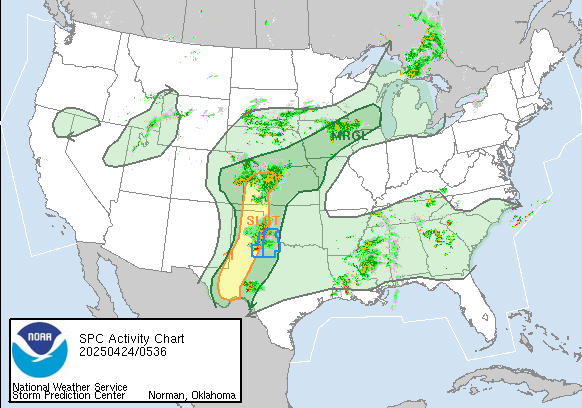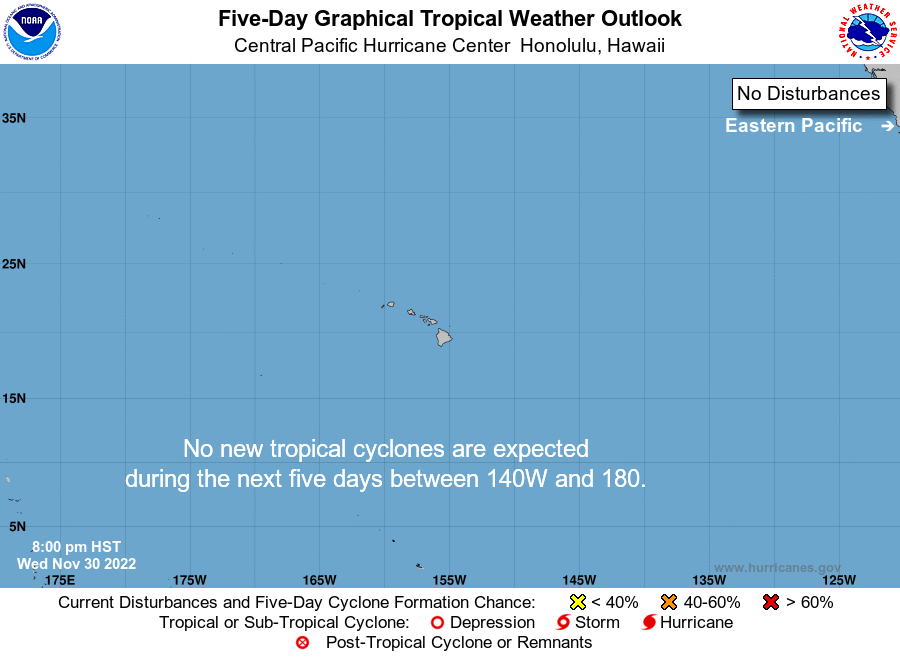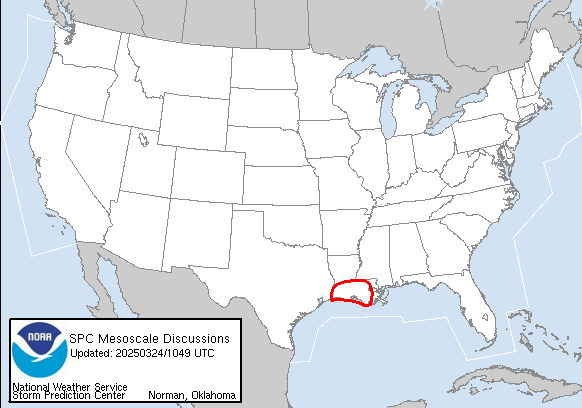Written by Sig Silber
HEADLINES (Updated 4:25 PM EDT) –
– Monsoonal thunderstorms expected in the Southwest through the weekend
– Thunderstorms likely along and ahead of a front from the Central Plains to Ohio/Tennessee Valleys to the Northeast/Mid-Atlantic; severe weather and heavy rain possible
– Fred is forecast to impact much of Florida with heavy rain as it crosses the Keys on Saturday
– Oppressive heat continues across the Northwest, Eastern Seaboard, and South-Central CONUS

This article provides continuous updates for a variety of Weather and Weather-Related Threats as well as a general weather forecast. These are “Live” maps that continually update. Please pay attention to the Mesoscale Events maps — Mesoscale Events are potentially life-threatening situations.
Please share this article – Go to the very top of the page, right-hand side for social media buttons. Also, feel free to send this email to anyone you feel will benefit from it.
For those interested in longer-term forecasts, we just published the new NOAA Seasonal Outlook and it can be accessed here.
Readers can scan through this article or jump to where they want to go via the links to the right. To get back to the Directory, hit the back arrow at the top of the URL bar on your screen. But in many cases, one of my Editors has graciously inserted a Return to Directory link to click so that is even easier. This is so high tech that I hardly believe it. |
|
CONUS Focal Points

Short Range Focal Points
Short Range Forecast Discussion NWS Weather Prediction Center College Park MD
424 PM EDT Fri Aug 13 2021
Valid 00Z Sat Aug 14 2021 – 00Z Mon Aug 16 2021
…Monsoonal thunderstorms expected in the Southwest through the weekend…
…Thunderstorms likely along and ahead of a front from the Central Plains to Ohio/Tennessee Valleys to the Northeast/Mid-Atlantic; severe weather and heavy rain possible …
…Fred is forecast to impact much of Florida with heavy rain as it crosses the Keys on Saturday…
…Oppressive heat continues across the Northwest, Eastern Seaboard, and South-Central CONUS…
A busy weather pattern is in place through the weekend as multiple features set up to the south of a slow-moving upper-level trough stretching from central Canada into the north-central U.S. The Southwest Monsoon remains active with showers and thunderstorms anticipated for the next several days as monsoonal moisture continues to flow into the region. Within the last 30 days, portions of the Southwest have received 200-300 percent of average rainfall and thus are vulnerable to additional heavy rain. Accordingly, a Slight Risk of excessive rainfall and Flash Flood Watches cover the southern half of Arizona and New Mexico through Sunday.
Farther east, a surface cold front will propagate eastward across the northeastern quadrant of the county, while meandering over the Central Plains/Mississippi Valley. As moisture flows into the front, it should provide a focus for rain and thunderstorms, with both severe weather and flash flooding as possible threats. Today, the greatest chances for severe weather look to be ahead of the front in the Central High Plains, Ohio Valley, and portions of the Mid-Atlantic with Slight Risks delineated by the Storm Prediction Center. Similar to yesterday, scattered damaging wind is anticipated to be the predominant severe threat, and a Severe Thunderstorm Watch currently extends across Maryland into Virginia. Isolated flash floods are also possible today over a large Marginal Risk area stretching from Oklahoma north and eastward toward the Mid-South, Ohio Valley, Great Lakes, and Mid-Atlantic.
Then on Saturday, heavy rain looks to focus over portions of the Mid-Atlantic, and especially given the wet antecedent conditions, scattered flash floods are possible and a Slight Risk of excessive rainfall is in place. A few severe thunderstorms could also occur.
Meanwhile, Tropical Depression Fred is expected to skirt the north coast of Cuba today while remaining at tropical depression strength. Fred is anticipated to strengthen to a tropical storm and cross the keys on Saturday before turning north into the Eastern Gulf of Mexico. Ahead of Fred, bands of tropical showers/thunderstorms are already underway across Florida which could produce isolated flash flooding over South Florida including Miami.
As Fred tracks offshore the western Florida coast, additional bands of tropical thunderstorms will occur over Florida as deep tropical moisture streams in. Scattered flash floods are possible over South Florida tomorrow, before the flash flood threat expands over much of Florida and Southeast Georgia Sunday as Fred approaches the Florida Peninsula at tropical storm strength. Users are encouraged to follow the latest forecast information from the National Hurricane Center, as Tropical Storm Warnings are in effect for the Keys and areas offshore Southwest Florida.
Heavy rain aside, the ongoing oppressive heat continues to be a hazard during the short range period across multiple regions. The Northwest and North Great Basin can expect continued record-breaking heat in terms of both high minimum and maximum temperatures through this weekend. Excessive Heat Warnings and a few Heat Advisories cover much of the Pacific Northwest and Northern Great Basin as temperatures soar into the 100s in the Pacific Northwest and the Northern Great Basin.
The heat is forecast to lessen somewhat at least in the Seattle and Portland areas by Sunday, but the interior will remain hot, and above normal temperatures are expected to spread toward the Northern Plains to begin next week. In addition to the heat, Air Quality Alerts are in place for the Northwest and into parts of the Rockies given smoke from fires and high ozone levels. Unfortunately, isolated dry thunderstorms remain a threat through Sunday as well, which could worsen the ongoing fire situation in the West.
In the East, another day of high humidity and hot temperatures creating high heat indices well over 100F is expected, and Heat Advisories are in effect from North Carolina to Maine and also into portions of West Virginia, with Excessive Heat Warnings embedded in the northern Mid-Atlantic. By Sunday, the cooler air behind the passing cold front will break the hot streak and cool temperatures off to around seasonal.
We try to keep this up to date but if is not you can find the updated version here.
When you click on this image it takes you to the SPC Fire Warning Page and you get a set of maps for Days 1, 2, 3 – 8, etc. You can then click on those for more detailed information. The map is a bit blurry as I tried to make it a bit larger than the map provided by NOAA but should be able to see where the current wildfire risks are. But if you click on this map, you will get to see three maps that show the risk for different time periods.
Thunderstorm Risk
This should play out something like shown in this 60 Hour Forecast Animation
Here is a national animation of weather fronts and precipitation forecasts with four 6-hour projections of the conditions that will apply covering the next 24 hours and a second day of two 12-hour projections the second of which is the forecast for 48 hours out and to the extent it applies for 12 hours, this animation is intended to provide coverage out to 60 hours. Beyond 60 hours, additional maps are available at links provided below. The explanation for the coding used in these maps, i.e. the full legend, can be found here although it includes some symbols that are no longer shown in the graphic because they are implemented by color-coding.

The two maps below break it down by day and may be easier to read.
Now, the Day One and Two CONUS Forecasts: These Maps Update Daily.
Day One CONUS Forecast | Day Two CONUS Forecast |
These graphics update and can be clicked on to enlarge. You can see where the weather will be | |
 | |
During the winter much of our weather originates in the Pacific. That is why we pay attention to the near-term history of storms arriving.
Temperature
A version that shows a 40 hour animation and some other views can be found here

– Return to Directory
Day 3 – 7 Hazards
Valid Monday August 16 2021 – Friday August 20 2021
Hazards:
– Heavy rain across portions of the Central Great Basin, the Tennessee Valley, the Mid-Atlantic, the Southern Appalachians, the Southeast, the Ohio Valley, and the Southwest, Mon-Wed, Aug 16-Aug 18.
– Heavy rain across portions of the Upper Mississippi Valley and the Northern Plains, Wed-Thu, Aug18-Aug 19.
– Heavy rain across portions of the Central Plains, the Southeast, the Middle Mississippi Valley,the Upper Mississippi Valley, and the Northern Plains, Thu-Fri, Aug 19-Aug 20.
– Heavy rain across portions of the Southeast, Mon, Aug 16.
– Flooding possible across portions of the Southeast.
– Flooding occurring or imminent across portions of the Southeast.
– Excessive heat across portions of the Central Great Basin, California, the Northern Plains, and the Southwest, Mon, Aug 16.
– Excessive heat across portions of the Central Plains and the Northern Plains, Mon-Tue, Aug 16-Aug 17.
– Heavy rain across portions of mainland Alaska, Mon, Aug 16.
– Heavy rain across portions of the Alaska Panhandle and mainland Alaska, Tue-Fri, Aug 17-Aug 20.
Detailed Summary:
The medium range forecast period (Monday, August 16 to Friday, August 20) features typical summertime weather hazards, with a few tropical systems to track as well. Starting in the southeastern United States, Tropical Depression Fred is currently forecast to slightly strengthen and regain tropical storm strength before making landfall over the Florida Panhandle on Monday. Fred is then expected to weaken and push inland near the Georgia and Alabama border through Tuesday. As a result, the most impactful hazard is likely to be associated with heavy rain near and to the east of the center due to the expected unorganized structure of Fred over the Florida Panhandle on Monday and portions of the Southeast through Wednesday as moisture lingers along a dissipating stationary boundary.
Farther north, the aforementioned front may draw tropical moisture into the southern Appalachians, western Carolinas, and eastern Tennessee Valley early next week. Uncertainty regarding the highlighted heavy rainfall areas and exact rainfall amounts remains higher than average due to Fred’s disorganization, but regardless of Fred’s future, heavy rain near and ahead of the approaching frontal boundary could lead to isolated flooding concerns.
Otherwise, a separate tropical disturbance (labeled Potential Tropical Cyclone Seven) and a feed of rich atmospheric moisture may impact southern/central Florida with heavy rain by the end of next week. As always, be sure to check with the National Hurricane Center for the latest tropical cyclone forecasts and outlooks.
Elsewhere, heavy rain is also expected to impact drought-stricken regions of the Southwest and Northern Plains. Monsoonal showers are expected to continue producing scattered downpours over southern/central Arizona, New Mexico, and into southwestern Utah through at least Wednesday. That is when an associated retrograding upper-level low is forecast to exit into the western Pacific with the remaining atmospheric moisture escaping to the north and into the central Great Basin ahead of an approaching upper-level trough. For the Northern Plains and Upper Midwest, this section of the country is currently experiencing widespread extreme to exceptional drought, but some relief is on the way.
An approaching cold front could spark numerous showers and thunderstorms beginning midweek between the Northern Rockies and Northern Plains. Scattered rainfall amounts great than 1 inch are possible across northeast North Dakota and northern Minnesota, where precipitable water anomalies appear highest within the latest forecast guidance. By late-week the cold front is forecast to reach the Central Plains, thus producing chances of heavy rain in places such as Kansas, Nebraska, and portions of the Midwest.
Excessive heat will also remain a concern while gradually diminishing for parts of California, the central Great Basin, and the northern High Plains on Monday. Monday should be the tail-end of yet another heat wave for the western United States. Temperatures around 10 degrees above average with highs approaching the century mark are forecast across the Great Basin, with even higher temperatures found across the high deserts and San Joaquin Valley of California, before much cooler temperatures arrive on Tuesday.
However, dangerous heat will linger one additional day throughout the northern High Plains before below average temperatures enter this area by Thursday. By the middle-to-end of next week the only area with potentially oppressive heat will be found across South Texas and the western Gulf Coast. High temperatures in the mid-to-upper 90s will be close to normal for this time of year, but heat indices around 110 degrees and low temperatures only dropping into the 80s can be dangerous if proper heat safety is not followed.
For Alaska, a low pressure system and associated frontal boundaries will produce chances for heavy rain south of the Brooks Range on Monday throughout Interior Alaska. Heavy rain is also a possibility over the Alaska Panhandle and south-central portions of the state between Tuesday and Friday as two separate systems enter the Gulf of Alaska. Intense moisture transport overtop of an upper-level high located over the northeast Pacific could funnel multiple waves of heavy rain into coastal regions. Rainfall amounts of 2+ inches seem plausible throughout northern parts of the panhandle, with totals through the entire time period possibly greater than 5 inches.
(This is updated only during the week) Note the first list is weather highlights, this list is hazards. Not sure there is that much of a difference but they come from two different parts of NOAA. The Day 3 – 7 Hazards List does not update on weekends. But it is still useful as it remains valid for the period of time it covers. Of course, all forecasts are subject to change. Later we show a map of the hazards. Perhaps we should show them together. |
Click here for the latest complete Day 3 -7 Hazards forecast which updates only on weekdays. It includes the full discussion which I do not update in this article but only present the highlights.
– Return to Directory
Ski Snow Reports
We will resume snow coverage in the Fall
– Return to Directory
Drought Coverage
We include drought information in this section.


More information can be found here.
August Drought Outlook.

Seasonal Outlook Issued July 15, 2021

– Return to Directory
Tropical Events
Atlantic and Gulf of Mexico
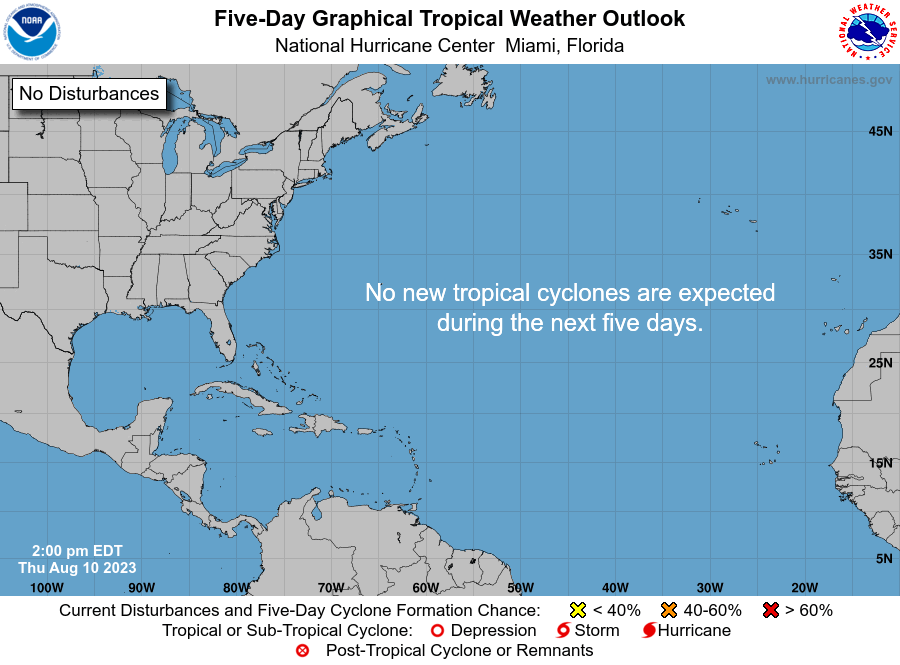


![[Key Messages]](https://www.nhc.noaa.gov/storm_graphics/AT06/refresh/AL062021_key_messages+png/233154_key_messages_sm.png)
The Eastern Pacific
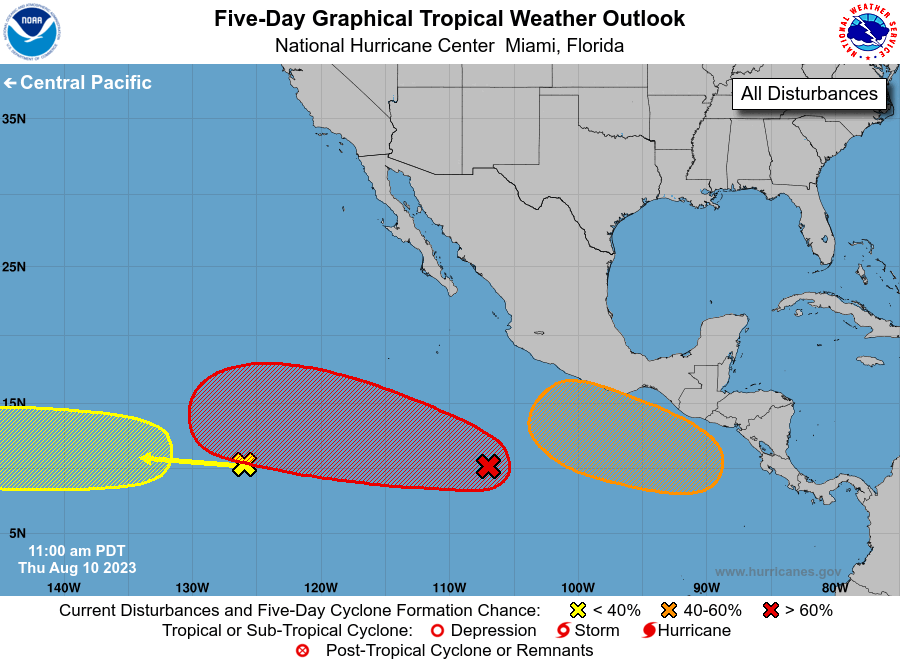


The Central Pacific
Updates on individual named storms can be obtained here.
And the Western Pacific
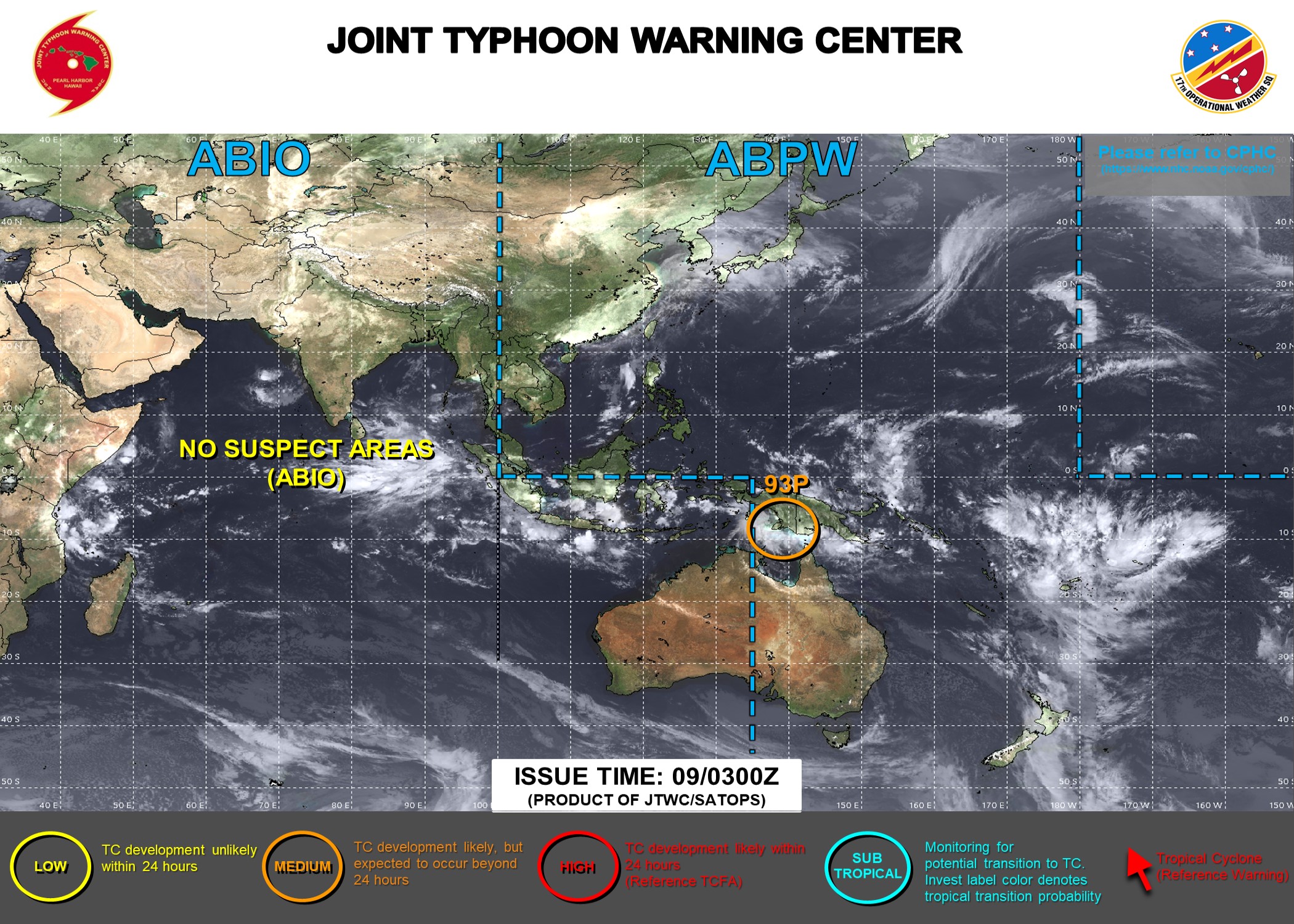

Weekly Tropical Forecast

– Return to Directory
Intermediate-Term Weather Forecast
And shifting to the Alaska and CONUS Intermediate-Term Weather Forecast showing from left to right, Days 1- 5, 6 – 10, 8 – 14 and Weeks 3 – 4 You can click on these maps to have them enlarge, there are larger versions in the Addendum (More Weather the link is shown at the end of this section, and there are larger versions of these maps in the Addendum. Also, the discussions that go with these forecast maps can be found here (first two weeks) and here (Weeks 3 and 4).
First Temperature
And then Precipitation
For those interested in more detail, there are additional weather maps and information in the MORE WEATHER Addendum. The link to the Addendum is here. |
– Return to Directory
Mesoscale Events
The following map shows where mesoscale events are occurring or forecast. If you do not see any areas highlight on this map than there are no mesoscale events taking place or forecast. A mesoscale event is a very serious situation for a very small area and detailed information is provided for these events when they occur or are forecast. If a mesoscale event is shown, click on the map and more detail on the event will be shown.
Two different parts of the NWS issue this map and they are not always in agreement although they are pretty close. They (Norman Oklahoma and College Park Maryland) issue the alerts when they realize the need, so it is best to look on both maps and click one or both if you see areas highlighted.
This next map showing where “Headlines” have been issued for convection (and an animation of the recent movement of storms) should update and you should be able to click on to get additional details but if it does not update when you click on it, click here.
There is a slight difference between convection and thunderstorms. The below map shows where “Headlines” have been issued for Thunderstorms. You should be able to click on the map to get additional details but if it does not update, you can click here.
The map below shows the current wildfire risk which becomes more significant as we move into Summer. When you click on this image it takes you to the SPC Fire Warning Page and you get a set of maps for Days 1, 2, 3 – 8, etc. You can then click on those for more detailed information. The map is a bit blurry as I tried to make it a bit larger than the map provided by NOAA but should be able to see where the current wildfire risks are. But if you click on this map, you will get to see three maps that show the risk for different time periods.
– Return to Directory
Now the Day 3 – 7 Hazards Outlook Maps

The orange and red outlined areas are what is most concerning of the forecasted Day 3 – 7 Hazards. This graphic does not update during the weekend. There is a discussion that goes with this graphic and you can access that discussion here.
The following is provided to help the reader relate the maps to how NWS will describe an area of the U.S.

– Return to Directory
Now to our More Detailed Weather Report
This graphic is about Atmospheric Rivers i.e. thick concentrated movements of water moisture. More explanation on Atmospheric Rivers can be found by clicking here or if you want more theoretical information by clicking here. The idea is that we have now concluded that moisture often moves via narrow but deep channels in the atmosphere (especially when the source of the moisture is over water) rather than being very spread out. This raises the potential for extreme precipitation events.
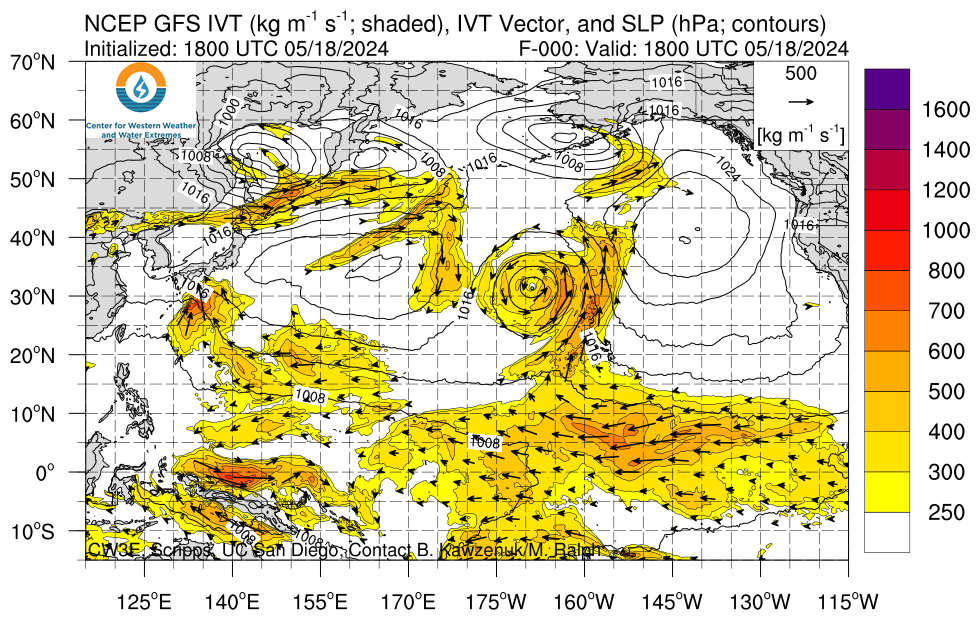
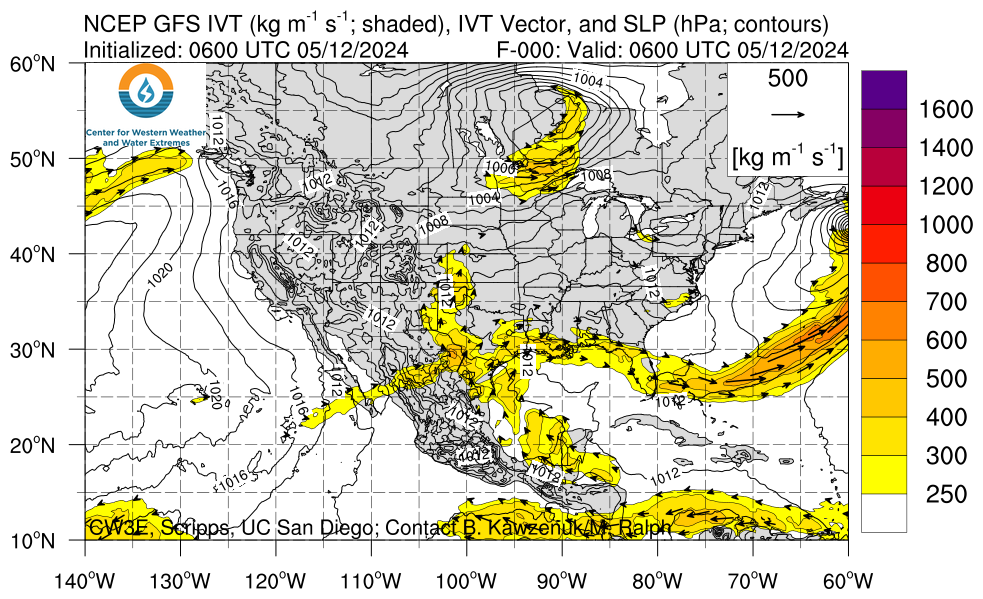
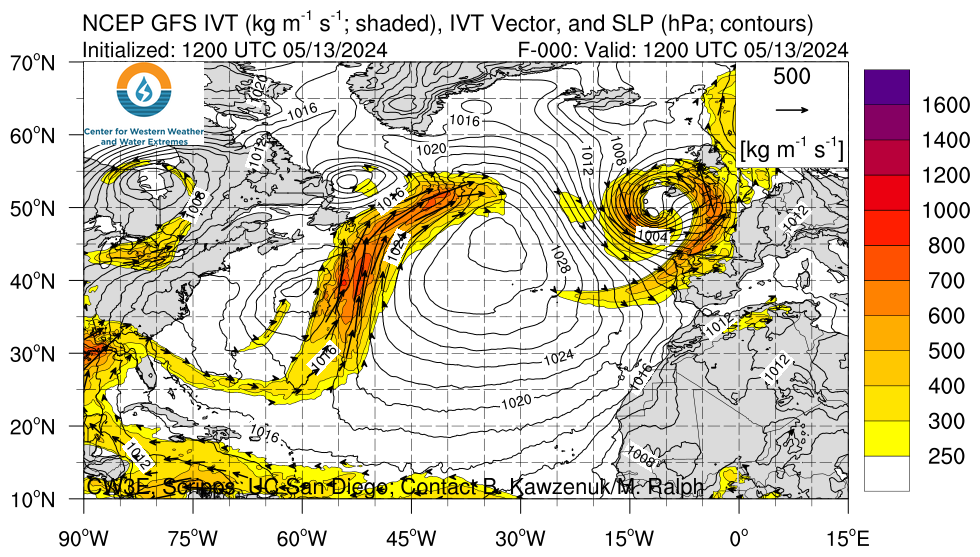
500 MB Mid-Atmosphere View
The map below is the mid-atmosphere 3-Day chart rather than the surface highs and lows and weather features. In some cases, it provides a clearer less confusing picture as it shows only the major pressure gradients. This graphic auto-updates so when you look at it you will see NOAA’s latest thinking. The speed at which these troughs and ridges travel across the nation will determine the timing of weather impacts. This graphic auto-updates I think every six hours and it changes a lot. Thinking about clockwise movements around High-Pressure Systems and counterclockwise movements around Low-Pressure Systems provides a lot of information.


| Day 3 Above, 6 Below | Day 4 Above,7 Below | Day 5 Above. |
 |  |  |
 |  |  |
Here are the precipitation forecasts. First the cumulative for Days 1 – 3

Then cumulative for Days 1 – 5
Then cumulative for Days 1 – 7

Looking ahead to next week.

– Return to Directory
Additional Tools to Obtain Watches and Warnings
| Current watches, warnings, and advisories issued by the agencies of the National Weather Service. Hazards should show up in the various maps but the below links will take you to all outstanding watches and warnings in each category which may include some categories not covered in the various maps or difficult to find. So if there is a category of interest, click on the appropriate link below. |
|
Below you will see a number of different maps that are updated in real-time, making this a “live” report. If a part of one or more of the maps shows an area that is highlighted, you can click on it and get the full current report. By having the reader click on these active situations rather than having GEI do so, you will not miss any events in which you might have an interest and which we had not noticed and the page will not get cluttered with warnings, etc that have since expired.
Our focus here is events that are likely to last in the range of six hours but there can be longer or shorter events that are addressed by the Storm Prediction Center which is the main source of the information in this article. Long-term major events like a Hurricane are more likely to be in a separate article. But that may not always be the case. Since in general, all the links on this page transfer you into the NOAA system, in order to get back into this article you need to either close the tab to which you were transferred or click back on the tab that has this article.
| Live Warning Maps which If Severe Weather is Shown can be Clicked on to get more detail about these events. If there is a current warning shown on the map, click on the map for additional information related to the event. | These maps are updated as risks are identified. |
| This is the current graphic showing any mesoscale discussions (MD’s) which are in effect over the contiguous United States. Please read the description of the purpose of our MD’s for further information. Details on all valid MD’s may be found on our Current Mesoscale Discussions page. | 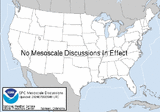 |
| Convective Outlooks | |
|---|---|
| This is today’s forecast for organized severe thunderstorms over the contiguous United States. Please read the description of the risk categories for further information. You may find the latest Day 1 Outlook available as well as all Outlooks issued today online. | Today’s Outlook |
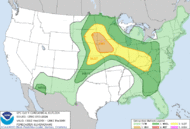 | |
| This is tomorrow’s forecast for organized severe thunderstorms over the contiguous United States. Please read the description of the risk categories for further information. The latest Day 2 Outlook is available as well as all Outlooks that have been issued today. | Tomorrow’s Outlook |
 | |
| This is the day after tomorrow’s (day 3) forecast for organized severe thunderstorms over the contiguous United States. Please read the description of the risk categories for further information. The latest Day 3 Outlook is available as well as all Outlooks that have been issued today. | Day 3 Outlook |
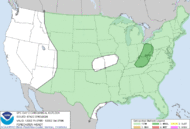 | |
| This is the day 4-8 forecast for organized severe thunderstorms over the contiguous United States. The latest Day 4-8 Outlook is available as well as all Outlooks that have been issued today. Note: A severe weather area depicted in the Day 4-8 period indicates a 30% or higher probability for severe thunderstorms (e.g. a 30% chance that a severe thunderstorm will occur within 25 miles of any point). | Day 4-8 Outlook |
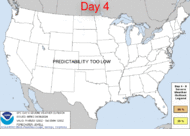 | |
| The Thunderstorm Outlooks depict the probability of thunderstorms across the contiguous United States in 4 or 8 hour time periods. The probabilistic forecast directly expresses the best estimate of a thunderstorm occurring within 12 miles of a point. The three probabilistic forecast thresholds are 10, 40, and 70 percent. | Thunderstorm Outlook |
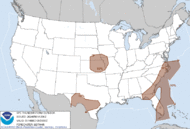 | |
| Fire Weather Outlooks | |
| This is today’s forecast for organized wildfires over the contiguous United States. Please read the description of the risk categories for further information about this product. | Today’s Outlook |
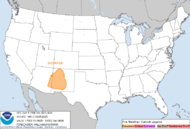 | |
| This is tomorrow’s forecast for organized wildfires over the contiguous United States. Please read the description of the risk categories for further information about this product. | Tomorrow’s Outlook |
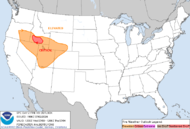 | |
| This is day 3-8 forecast for organized wildfires over the contiguous United States. Please read the description of the risk categories for further information about this product. | Day 3-8 Outlook |
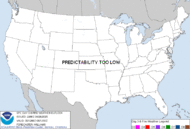 | |



